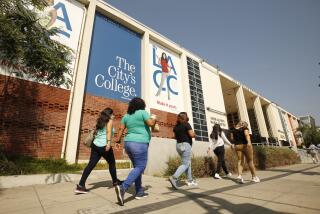KOCE HOPES TO MAINTAIN PROGRAMS
- Share via
Officials at KOCE-TV say they hope to continue the same level of public television programming, even though they are uncertain of the impact of a decision to establish a training academy at the station.
“It is our intent--it has always been part of our mission--to provide that type of community programming, as well as meet the educational needs,” KOCE President William Furniss said Wednesday night, after the Coast Community College District Board of Trustees voted to continue operating and subsidizing the Channel 50 station at Golden West College.
“We are still a public television station, and we have certain (federal) licensing criteria that require us to remain so,” Furniss said. “I think the (board’s) decision is a positive and encouraging one--it tells us they recognize the full licensing responsibilities as well.”
But to maintain its current public television level, including Public Broadcasting Service specials, KOCE must raise far more money from private sources, Furniss said.
In 1984, the district board tentatively voted to transfer operational control of the station to the KOCE-TV Foundation by January, 1987, and phase out subsidies by mid-1987.
By a 5-0 vote Wednesday, the board reversed that decision and agreed to established a “Cooperative Television Academy” that would be the county’s largest telecommunications training program.
According to district Chancellor David Brownell, the academy would train 300 students a year from the district’s three colleges, starting in August, 1987.
The academy will be fiscally stable, he said, and will meet more directly the educational needs of the district, which owns the Huntington Beach-based station.
Before Wednesday’s action, faculty representatives from Golden West and Orange Coast colleges had urged the board to stick to the phase-out plan. For years, many district teachers have argued that the station was a drain on district taxpayers and failed to serve district students adequately.
KOCE officials maintain that the station has met both district and community responsibilities. According to station manager Donald Gerdts, 45% of the station’s programming is directly educational--25% in college telecourses, 10% in public school instructional programs and 10% in several “how-to” series. The remainder, he said, is devoted to “cultural and informational” programs.
The Federal Communications Commission “doesn’t put a lock on exactly how much we program in each area,” Gerdts said. “But the agency makes it clear that we must have substantial programming in all three (educational, cultural and informational).”
That means, he said, continuation of not only national PBS programs but also locally produced public affairs programs, such as “Jim Cooper’s Orange County,” and various arts shows, such as the projected PBS specials from the Orange County Performing Arts Center and a proposed “Arts Scene” series presented by the Orange County Arts Alliance.
It is uncertain whether the station can raise enough money in 1986-87 from community donors to maintain its current $6-million annual operating and programming budget.
“We expect to get the same district allocation we’re getting now--around $1 million--and our federal grants have been running about $900,000,” Furniss said. Some money also comes from production contracts and related services.
The bulk of the balance must come from private firms and viewers, Furniss said. But efforts to tap those sourses remain “greatly underdeveloped” despite an accelerated push by the station’s fund-raiser organization, the KOCE-TV Foundation.
KOCE has yet to find corporate underwriters for the projected $2.3-million series “Tonight from the Pacific,” Furniss said. The series, keyed to taped performances and backstage profiles at the Orange County Performing Arts Center, is still “in the works.”
Financially, KOCE still suffers in comparison with the far larger KCET, Channel 28, in Los Angeles, which has an annual budget of $23.7 million and which offers many of the same PBS specials.
More to Read
Sign up for Essential California
The most important California stories and recommendations in your inbox every morning.
You may occasionally receive promotional content from the Los Angeles Times.










